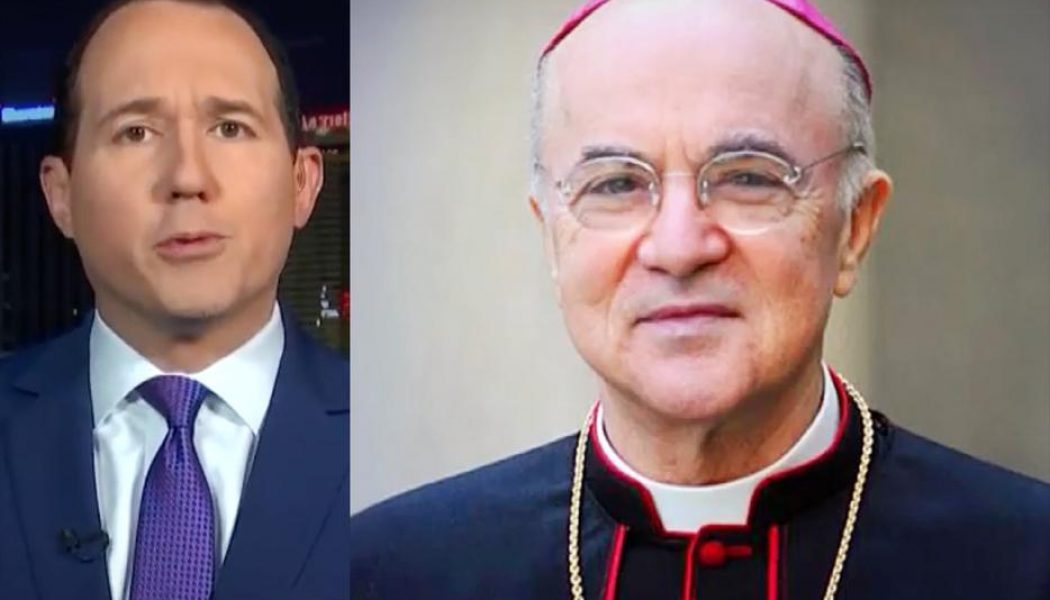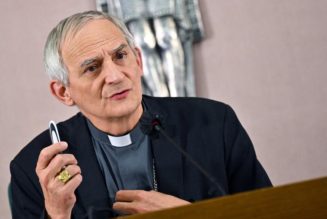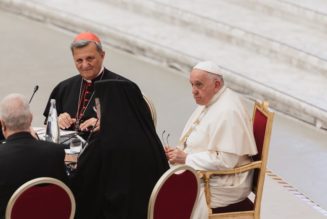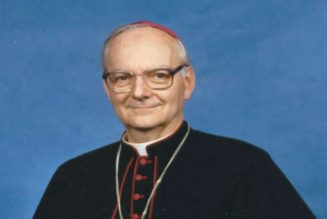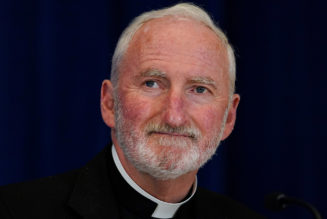
More than any other person except for Theodore McCarrick himself, Archbishop Carlo Maria Viganò is responsible for triggering the 449-page Vatican report released this week that details what other Church leaders knew about the disgraced ex-cardinal’s decades-long pattern of sexual misconduct, and the actions they took or failed to take with respect to what they had learned.
As the report itself documents, the archbishop was the first senior Vatican figure to call concretely for action to be undertaken against McCarrick, at a time when Archbishop Viganò was serving as a senior official in the Secretariat of State. Then, after the archbishop was subsequently posted to Washington as the U.S. nuncio from 2011 to 2016, he was again involved with the Vatican’s handling of the McCarrick file.
And in August 2018, Archbishop Viganò released his initial 11-page “testimony” regarding McCarrick, in which he accused numerous Church leaders of turning a blind eye to McCarrick’s misconduct — including the explosive claim that he personally told Pope Francis about the transgressions following the Holy Father’s election in 2013, and that the Pope ignored this information and tapped McCarrick to carry out duties on the behalf of the Vatican. The firestorm sparked by Archbishop Viganò’s document resulted in the Holy Father’s formal authorization of an investigation of all relevant documentation related to the allegations against McCarrick, and how they were handled.
While this week’s report acknowledges Archbishop Viganò’s role in drawing Vatican attention to McCarrick’s actions, it also states that the archbishop failed to follow up on a request to investigate an allegation that came to light while he was serving as nuncio. It also discounts his charges against Pope Francis, stating that the archbishop’s account of their interaction “is sharply disputed.”
In this interview with EWTN’s The World Over host Raymond Arroyo, Archbishop Viganò discusses the report, and takes issue with the criticisms it directs at him as well as with numerous other aspects of the report’s findings.
* * * * * * *
Raymond Arroyo: Here to respond to the report, we’re pleased to be joined by Archbishop Carlo Maria Viganò, who joins us via phone. Your Excellency, thank you for being here. The report claims you did not come forward. That’s the quote to present evidence for this Vatican inquiry. Were you asked to provide information for this McCarrick report? Did anyone reach out to you?
Archbishop Viganò: I am surprised to discover that a report in which I am mentioned 306 times accuses me of not having presented myself to testify in this Vatican inquiry of Theodore McCarrick. But according to the norm of the canon law, the calling of witnesses is the responsibility of the one who is in charge of the process.
Raymond Arroyo: So, Archbishop, they never reached out to you then to ask you to contribute to the report, to interview you?
Archbishop Viganò: Yes, it is completely incomprehensible and anomalous that it was not considered opportune to call upon me to testify, but even more disturbing that this deliberate omission was then used against me. Let it not be said to me that I have made myself untouchable, because the secretary of state has my personal email address, which is still alive and never has been changed.
Furthermore, it is also significant to me that James Grein — the only victim of McCarrick’s sexual molestation who had the courage to denounce him publicly — does not appear in the report and that there is no trace of his testimony, in which he would also have reported the trip he made with McCarrick to St. Gallen at the end of the 1950s.
Raymond Arroyo: Hmm, interesting.
Archbishop Viganò: From public statements of James Grein, it is clear that the beginning of McCarrick’s climb — he was then a young, newly ordained priest — coincided with that visit to Switzerland, to a monastery that was later the site of the meeting of the conspirator of the so-called “Saint Gallen Mafia.” And according to the declaration deceased Cardinal Godfried Danneels, that group of prelates decided to support the election of Bergoglio, both after the death of John Paul II as well as during the conclave that followed the controversial resignation of Benedict XVI.
Then Cardinal McCarrick admitted to having supported the election of Cardinal Bergoglio at the beginning of the general congregations prior to the conclave that had been held a few months earlier.
I wonder what sort of reliability a judicial body can have that had such an obvious conflict of interest due to its past relationship with the accused.
How can [Pope] Bergoglio, and the Secretariat of State that depends on him, pretend to appear impartial when McCarrick went to the Vatican with an abnormal frequency? When, in June 2013, he was tasked with making that diplomatic trip to China? And how can one not think that their repeated attempts to cover up and denial of their responsibility, are the cause of the systematic effort to discredit me as a witness in order not to bring to light their complicity in circumstances that exist between them and the guys themselves?
Raymond Arroyo: Your Excellency, the Pope, according to the report, maintains that you did not inform him of McCarrick’s activities or restrictions on McCarrick in June of 2013. The Pope was certain that you as nuncio “never told him that McCarrick had committed crimes against any person, whether adult or minor, or described McCarrick as a serial predator.” Your response?
Archbishop Viganò: This statement is absolutely false. First of all, it was Bergoglio himself, on June 23, 2013, who explicitly asked me my opinion of McCarrick. As I testify in my 2018 memoir, I answer him with complete frankness: “Holy Father, I don’t know if you know Cardinal McCarrick, but if you ask the Congregation for Bishops, there is a dossier this thick about him. The corrupt generation of seminarians and priest and Pope Benedict ordered him to withdraw to a life of prayer and penance.”
The Pope did not make the slightest comment about those very grave words of mine and did not show any expression of surprise on his face, as if he had already known the matter for some time and he immediately change the subject. But then, what was the purpose in asking me that question: “What is Cardinal McCarrick like?” He clearly wanted to find out if I was an ally of McCarrick or not, of course. It should be noted that I had learned from McCarrick himself that Bergoglio had received him four days before my audience on the 23rd of June and that Bergoglio had authorized him to go to China.
What was then the point of asking me for an opinion when Bergoglio already had McCarrick in the highest esteem? And in May 2014, I learned from The Washington Times of a tweet made by McCarrick to the Central African Republic on behalf of the Department of State.
Beginning in 2008, Benedict XVI had ordered the American cardinal to retire to a private life, not to celebrate or attend public events. For this reason, I asked, I wrote to Cardinal Parolin, if the sanction against McCarrick was still to be considered valid? That I had received no response whatsoever.
Raymond Arroyo: And Your Excellency, you saw the report says there’s no documentation of this. They don’t have documentation, so therefore they dispute it. You would say what to that?
Archbishop Viganò: Yes, I didn’t… I was not able to go all along the 400 pages in all the documents, but, you know, it’s interesting that they didn’t produce, in order to cover up also Cardinal Parolin, who didn’t answer to me. And from the report, I learned that McCarrick’s continued assignment and travels abroad were considered — this is stated in the report — they were considered by Archbishop Wuerl (Cardinal Wuerl) and even by Nuncio Sambi “as a sufficient form of removal” between quotation. That amazes me.
So the report continues, and I quote: “the indications were not ‘sanctions;’ they were not imposed by Pope Benedict XVI; McCarrick was never forbidden to celebrate Mass in public; McCarrick was not prohibited from giving lectures; Cardinal Re did not impose on McCarrick ‘the obligation’ of dedicating himself to a life of prayer and penance; and McCarrick remained free to conduct activities, including travel, with the permission of the Holy See, including the Nuncio,” as they stated. So, it means that despite the cardinal’s reprehensible conduct the Holy See did not consider it appropriate to take disciplinary measure against McCarrick, which confirms my demonstration of the corruption of the Curia.
Raymond Arroyo: Your Excellency, the report goes to great pains to paint you as somehow lax in investigating the claims of Priest 3 in 2012. Now the Vatican says you brought the concerns of this priest, who claimed he was abused by McCarrick, you brought those concerns to the Holy See, to Cardinal Ouellette, who instructed you to investigate them, but then he claims he never heard back from you. Did you avoid placing yourself, as the report says, “in a position to ascertain the credibility of Priest 3?” They said you never contacted the priest, the vicar general of Metuchen or the bishop as instructed. Your reaction?
Archbishop Viganò: It is obvious what my role was in bringing McCarrick’s scandal to light. And that I have always taken steps to report any information that came into my possession to the Holy See. I recall that we are talking about 2012, when I had just been appointed nuncio to the United States.
In the report I am accused, as you’ve said, of not having followed up on the request for information regarding the accusation made by Priest 3 — do not mention his name. This is absolutely false. It is the writers of the report themselves who provide the evidence of the deception they had concocted in order to strike and discredit me. In fact, in another place of the same report, it says that on June 13, 2013, I wrote to Cardinal Ouellette, sending him both the letter that Bishop Bootkoski had written to me as well as the letters he sent to Priest 3. I informed him that the civil case of Priest 3 had been dismissed without the possibility of appeal. And Bishop Bootkoski, of Metuchen, characterized the accusations of Priest 3 as false and slanderous.
I would like to emphasize one aspect in particular: Those who accuse me of not having sent a written communication to Bishop Bootkoski, the ordinary of the Priest 3 and bishop of Metuchen, know very well that this depends on the precise direction of the Secretariat of State.
They know equally well, as the report confirms, that there was a telephone communication between Bishop Bootkoski and me, about which I in turn informed Cardinal Wuerl.
It should not be forgotten that in those years there were lawyers who were not content to bring dioceses to judgment for crimes committed by priests, but who wanted to demonstrate that the Holy See itself — like the headquarters of a multinational company — held the ultimate responsibility for giving compensation to victims of molestation. The lawyer, Jeffrey Lena, who probably has worked very hard for this report.
Raymond Arroyo: This is fascinating and we’ll have to… I wish we had more time to explore this, but I do recall reading that reference that you make to the communication with Cardinal Wuerl, but I didn’t connect the two, and I imagine most people reading the report wouldn’t either. But that makes sense. There is a footnote, Your Excellency, that repeats your testimony, where you maintain in 2006 and 2008 you asked your superiors “to intervene as soon as possible by removing the cardinal’s hat and reducing McCarrick to the lay state” in the full memorandum that they published. They claim you added, “if the allegations are true and proven.” Now, the report attempts to use this to undermine your testimony as some are maintaining. Your response to that? Does this in any way undermine your testimony that you qualified the penalty by saying, “if the accusations are proven true?”
Archbishop Viganò: Well, the accusation that were brought to my attention, and previously to my predecessors, they proved that there was a number of seminarians that were well known that had denounced the abuses of Cardinal McCarrick. So for that, when I wrote in my report for 2006 and 2008 to my superior, the secretary of state, I have no doubt, no doubt that there was the case to proceed immediately after, of course, a due procedure, that was a corresponding to the authority of the Pope himself to take very strong, exemplary measures against Cardinal McCarrick. In fact, what I suggested in 2006 and 2008 has been accomplished. Ten years later, or more, 11 years later. So that was proof that my judgment was absolutely correct on the situation.
Raymond Arroyo: Your Excellency, before I let you go, I’d like your reflections on the report placing the lion’s share of the blame for McCarrick’s rise in the Church at the feet of John Paul II and Benedict XVI. And when you read the report, as I did, it’s clear that there was a network of bishops here that remain unnamed who protected McCarrick, either through patronage or personal contacts — or perhaps they were fellow travelers, but this network seems to be firmly in place.
Archbishop Viganò: Yes, I mean, the intentions of the ones who drafted the report are clear: to pass off responsibility for the promotion of McCarrick to his predecessors. One of whom is deceased and canonized (John Paul II) and the other is so old and weak (Benedict XVI). The former cannot defend himself from the grave.
The disturbing thing is that, within the report itself, obviously put together by many hands, there are numerous contradictions. Enough to make the argument the report has little credibility. I wonder then who convinced John Paul II and then Benedict XVI not to take into account the serious accusations against McCarrick? Who had an interest in getting McCarrick promoted so that they could gain an advantage in terms of power and money? Someone probably made John Paul II believe that the accusations against McCarrick were fabricated following the model of the skeleton operation that communist Poland had already carried out against good bishops and priests who oppose the regime.
In the case of John Paul II, the main party interested in the promotion of McCarrick was definitely Cardinal Sodano. He was secretary of state until September 2006. All information came to him. In November 2000, he already had received information from Nuncio Montalvo for this report of the accusation of grave abuse committed by McCarrick. Let us not forget that in this period, the scandal of Father Maciel broke out, which Sodano sought to cover up by falsifying a statement of Benedict XVI.
I was present to that in which it was said that the pope considered the case closed. Benedict XVI called a plenary session of the Congregation for the Doctrine of the Faith, and Cardinal Arinze, who was a member of that congregation at that time, succeeded in having Maciel condemned despite the opposition of the secretary of state. And after that, the name of Cardinal Sodano also appears in connection to a scandalous real estate speculation in the United States.
The same connection, the same complicities, the same acquaintances always recur. McCarrick, Clinton, Biden, the Democrats, the modernists, along with a procession of homosexuals and molesters — that is not irrelevant. With regard to Benedict XVI, they want to have very direct access to the Pope where the secretary of state, Bertone, and the substitute Sandri were able to control and filter information about McCarrick and exert pressure on the Holy Father.
Regarding the situation of Pope Benedict, the report speaks for itself. The one — and it is stated in the report — the one who presented the question directly, of McCarrick, directly to Pope Benedict XVI, was Cardinal Bertone. Who, contrary to what I have repeatedly proposed — namely, that the very grave and detailed accusations against McCarrick required an exemplary canonical process leading to his removal from the cardinal college and his reduction to the lay state — led Pope Benedict to decide that no canonical process should be undertaken, nor should any canonical sanctions be proscribed, but that instead, and I quote, “a simple appeal to McCarrick’s conscience and ecclesial spirit” would be made.
And here yet another flagrant contradiction appears evident. How is it possible to reconcile a simple appeal to conscience with a form of instruction that was given both to the Nuncio Sambi and to me, according to which McCarrick could not reside in the seminary where he was living, could not participate in public activities, could not travel and had to lead a retired life of prayer and penance?
Raymond Arroyo: Mm-hmm.
Archbishop Viganò: The corruption at the highest level of the Vatican is so evident that it may want to consider the report as an unworthy attempt to make Bergoglio appear absolutely alien to the manipulation of the Curia — indeed, as a sort of implacable persecutor of the corrupt, while the evidence of the facts demonstrated the opposite.
Yes, I would like to also to note that the fact of blaming John Paul II for the appointment of McCarrick, despite the negative opinion of the Congregation for Bishops and its Prefect Cardinal Re, could be applied also to Jorge Bergoglio himself. About whom the Superior General of the Jesuits expressed strong reservatiosn. If Wojtyla made a mistake with McCarrick, and for this reason is considered implicitly responsible for the scandals that occurred, what happened? What prevented this judgment from also being extended to the promotion of Bergoglio as Bishop of Buenos Aires and then as a cardinal?
Let us remember that in the consistory of 2001 — and this is something really very suspicious — in addition to McCarrick and Bergoglio, other leading members of the Saint Gallen Mafia received the red hat.
Raymond Arroyo: Archbishop Carlo Maria Viganò, we thank you for being here tonight and for your insights into this report, which are quite unique, and you had a front row seat to so much of what we’re seeing unfold. I thank you for being here. I hope you’ll come back again.
Archbishop Viganò: Thank you very much, Raymond. I’m very pleased to be part of your program. Thank you.
Join Our Telegram Group : Salvation & Prosperity
